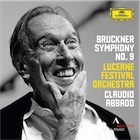Vienna Philharmonic
Herbert von Karajan
May 27 1962
Archipel Desert Island Collection (ARPCD 0546)
(This disc also includes Bruckner’s Te Deum, from the same concert)
Lucerne Festival Orchestra
Claudio Abbado
Deutsche Grammophon 4793441
Separated by just over 50 years, this pair of live recordings of Bruckner’s last symphony
present a number of interesting contrasts. Herbert von Karajan’s performance
from May 27 1962 is the first of his 12 recordings of the symphony. Claudio
Abbado’s performance, recorded over a span of 5 days in August 2013, was his
final ever recording before his sad death in January of this year. So we have
two great Brucknerians, one at the very end of his career and the other at the
beginning (at least of his recorded legacy).
It would be hard to imagine two more different approaches.
The timings tell the tale. Both conductors use the 1951 Nowak edition. Karajan
comes in at a very brisk 53’45”. Abbado is much more expansive at 62’30”.
Scanning John Berky’s Bruckner discography turns up very few recordings quicker
than von Karajan (one of them being a justly celebrated Barbirolli live
performance from 1966 with the Hallé Orchestra). Abbado’s timing is more
mainstream.
Von Karajan attacks the first movement with great urgency
and maintains momentum throughout. It is a very exciting performance, but not
one that fully observes the Feierlich misterioso guidance – there is not much
solemnity in the movement and the mystery really only comes in the coda. The
second movement is much more in line with Bruckner’s concept, bringing out the
menacing rhythms of the scherzo and trio. The third movement adagio is where it
really all comes together. Karajan allows the lyrical dimensions of the
movement to emerge in ways that he didn’t in the first movement. Here it really
is Feierlich, building up to a very powerful climax and dissolving in the
coda.
A key to Abbado’s very contrasting interpretation comes in a
remark from his assistant Gustavo Gimeno quoted in the booklet: “He conducted
with broad, slow movements, with a long musical line, trying to create a form
in which the musical discourse could develop. Slow, but flowing”. The great
strength of Abbado’s conducting is his success in combining rhythmic urgency
with expansiveness and an extraordinary clarity. There is a price to pay,
though. The edge is taken off some of the more climactic and dissonant sections
– certainly in the first movement and to a lesser extent in the scherzo. The
Adagio is magnificent, however. The dissonant climax does not disappoint and
the performance lives up to Simpson’s description of the movement – “though not
his most perfect, it is his most profound”.
The sound quality is excellent on the Abbado and more than
acceptable on the von Karajan recording (which, unfortunately, has no liner notes
or recording details). For Bruckner enthusiasts the choice is easy. You need
both!


No comments:
Post a Comment